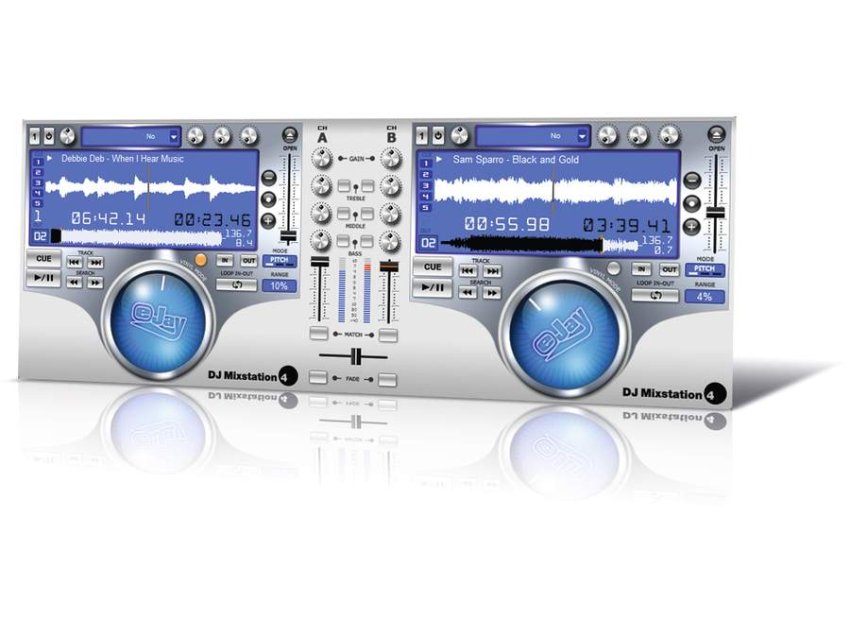MusicRadar Verdict
If you'd like to give digital DJing a try, DJ Mixstation 4 is a great place to start.
Pros
- +
Great automatic BPM detection. Dual waveform display works well. Reminiscent of real-world mixing tools. Sample pads for loop playback. Effects are decent.
Cons
- -
Doesn't always align the beats. You'll need two audio interfaces to use the cue channel.
MusicRadar's got your back
DJ Mixstation 4 is an entirely separate product from the rest of eJay range - in fact uses the engine from the well-regarded MixVibes DJing software and is all the better for it.
Hands on
Upon loading the program, the user is presented with two virtual decks, complete with eJay-branded jog wheels and animated waveform displays.
Your virtual record bag is known as the MediaBay and it's a simple task to add folders of audio files, then drag tunes onto the decks to play.
DJ Mixstation calculates their BPM for you, although when we switched from mixing house to drum 'n' bass, we had to adjust the program's tempo detection range, which by default goes to a maximum of 150BPM.
Mixing
When you have tracks on both virtual decks, you can automatically sync the tempo of one to the other. This takes away the challenge of getting the correct speed for each track, but if you're a purist, you can of course sync up your tunes manually, the old school way.
The tempo slider can be switched between standard pitch mode (where the tempo and key of the track change in unison, as they would on a traditional turntable or CDJ), tempo mode (where the key remains constant) and key mode (where the tempo remains constant).
This means it's possible to set the key and tempo of the track independently, which is useful if you want to make sure your mixes remain in key and/or in time.
The timestretching/pitchshifting quality is a bit grainy, but at this price, we can't grumble.
While DJ Mixstation will make sure a track plays at the right tempo, it doesn't automatically make sure the beats are in sync, even when using the match button.
This makes use of the jog wheel necessary to bring them into line. A waveform display at the bottom of the screen shows both tracks scrolling back to back, giving a useful visual aid for aligning them correctly.
The jog wheel can be switched to Vinyl Mode, allowing you to digitally scratch the track and spin it back. This might not sound quite like a real-world turntable but it certainly does an adequate job.
It's also possible to apply one of 14 effects to each deck, such as delay, phaser, langer, filter and distortion. There's an EQ, compressor and limiter on the master output too to assist you in getting a 'big' sound.
You can play sampled loops alongside your work using the built-in sample pads - 1000 loops are supplied for this very purpose.
Finally, there's an EQ with kill switches for each channel, but they're not as powerful as one might hope, as the decks can still be heard even with all of them engaged!
Summary
DJ Mixstation 4 lives up to its promise of delivering a low-cost solution that replicates real-world mixing tools in a way that'll make sense to DJs with prior vinyl or CD experience.
Newbies won't find the rudimentary manual much help (the online help was down when we tried it) and the lack of multi-out audio interface support is a kick in the nuts, but still, this is a good entry point into digital DJing.
Future Music is the number one magazine for today's producers. Packed with technique and technology we'll help you make great new music. All-access artist interviews, in-depth gear reviews, essential production tutorials and much more. Every marvellous monthly edition features reliable reviews of the latest and greatest hardware and software technology and techniques, unparalleled advice, in-depth interviews, sensational free samples and so much more to improve the experience and outcome of your music-making.
“If they were ever going to do the story of Nero, probably the most decadent of all the emperors, they would have to use Roy Thomas Baker”: A tribute to the legendary producer of Queen, Alice Cooper, Journey and more
“Built from the same sacred stash of NOS silicon transistors and germanium diodes, giving it the soul – and snarl – of the original”: An octave-fuzz cult classic returns as Jam Pedals resurrects the Octaurus
What’s the buzz? Meet Yellowjacket, Cherry Audio's recreation of EDP’s trend-setting Wasp from 1978











